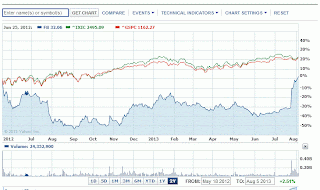Facebook is back in action....the price has moved from near-40 to below-18 to 38 within months:
At the current price of $38.40, Facebook is worth around $92 billion. But is it really worth that much? To attempt that question, let's have a look at its historical performance:
Facebook earned $32 m on revenue of $5 b in 2012. If we consider 2012 as a one-off year, extrapolating its Q1 2013 we get earnings of about $1.3 b on revenues of about $7 b. It had operating capital of about $4.6 b in 2012 and about $1.8 b in 2011.
There you have a firm earning a pretty decent rate on capital and trading at about 70 times its (extrapolated, future) earnings. Assuming Facebook as a high-growth business, is such a high value for growth justified? We can't tell anything about it since it is extremely difficult to value growth, especially for a technology business.
We know that historical profits don't really matter for the market for valuing businesses. Suddenly, it gets some insight on the firms' future profits for its model.
Facebook has about 2.4 b shares outstanding and some stock options too. While stock options are likely to grow in future, for simplicity we can do some math (no dilution in stock) to see how Facebook stands for its current valuation.
We can test this in another way: It is unlikely to pay any dividends in the next 10 years. If we believe that its latest earnings are sustainable and will grow in future, we can find out at what rate these earnings will have to grow in the 10-year period assuming Facebook would trade at about 25 times its earnings at that time, in order to earn a decent rate of return for the investor. Here's how it looks:
If an investor buys Facebook at the current valuation, (say, $92 b), its earnings will have to grow at about 27% compounded over 10-year period for the investor to earn about 15%. Is this possible for Facebook to pull of? I am not able to answer this. But you have to decide whether you want to take a chance just for earning 15%. Because the odds are: if earnings grow at 15%, the return for the investor would come down to 4%.
Next I want to look at the price at which one could be comfortable in buying.
If our assumptions (earnings and their growth, PE, no dilution and no dividends) stay, the investor has to buy Facebook at $69 b (about 25% lower than the current price) in order to earn 18% return on the investment. If he buys at 75% lower, the return would be about 32%!
Is this possible? The biggest challenge is the earnings growth. This is a call I cannot take. But some seem to be experts on these things. For them it is a piece of cake to get hold of the latest earnings, apply a growth rate to it and rationalize the price.
Watch the fun:
If earnings growth drops to 20%, our return would drop to 11.6% from 18% when bought at 25% discount to the current price.
Some more fun when earnings growth is at 15%:
Of course, you could say that Facebook's earnings would grow at 27% over the 10-year period and it would trade at 40 times its earnings at that time. Before you do that just
look for the companies trading at that rate. But then, anything is possible; life can be great.
Amazon did it although its
recent performance has been a little erratic.
Google has done well too.
Facebook's past performance may not be a very good indicator, but this is how it did compared to the broader market:
Facebook's
earnings are difficult to predict and its
managers are insiders.
In the final analysis, my conclusion is that I cannot buy Facebook at its current price and I cannot find a way to reasonably value it in order to decide on a price to buy either.
I don't care.
You decide for yourself.
























